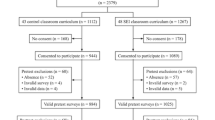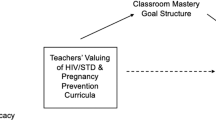Abstract
Background
Using data from a statewide relationship education (RE) program targeting a diverse adolescent sample, this study examined RE implementation in classroom environments.
Objective
The purpose of this study was to explore (1) whether there is a beneficial RE program effect for change in individual attitudes toward sexual delay, (2) whether individual factors—student gender and sexual activity—predict change in attitudes toward sexual delay for students experiencing the intervention, and (3) whether classmate characteristics influence individual change in attitudes toward sexual delay.
Methods
This study utilized multilevel modeling procedures to examine both individual- and classroom-level predictors of change in attitudes toward sexual delay.
Results
At the individual level, results indicated that females demonstrated more change in attitudes toward sexual delay than males and students who were sexually active demonstrated less change toward sexual delay compared with students who were not sexually active. At the classroom level, both racial composition and the proportion of sexually active classmates influenced individual attitude change. Although students in classrooms with higher proportions of African American peers demonstrated less attitude change toward sexual delay, the proportion of sexually active peers in the classroom appeared to be a more salient aspect of classmate composition.
Conclusions
Overall, this study supports the importance of considering both individual characteristics as well as social context when assessing program experience and effectiveness. Implications for future research and practice are offered.
Similar content being viewed by others
References
Adler-Baeder, F., Bradford, A., Skuban, E., Lucier-Greer, M., Ketring, S., & Smith, T. (2010). Demographic predictors of relationship/marriage education participants’ pre- and post-program relational and individual functioning. Journal of Couple & Relationship Therapy, 9, 113–132. https://doi.org/10.1080/15332691003694885.
Adler-Baeder, F., Kerpelman, J. L., Schramm, D. G., Higginbotham, B., & Paulk, A. (2007). The impact of relationship education on adolescents of diverse backgrounds. Family Relations, 56, 291–303.
Ajzen, I. (1991). The theory of planned behavior. Organizational Behavior and Human Decision Processes, 50, 179–211.
Bandura, A. (1977). Social learning theory. Englewood Cliffs, NJ: Prentice-Hall.
Belgrave, F. Z., Van Oss Marin, B., & Chambers, D. B. (2000). Culture, contextual, and intrapersonal predictors of risky sexual attitudes among urban African American girls in early adolescence. Cultural Diversity and Ethnic Minority Psychology, 6, 309–322.
Brener, N. D., Billy, J. O., & Grady, W. R. (2003). Assessment of factors affecting the validity of self-reported health-risk behavior among adolescents: Evidence from the scientific literature. Journal of Adolescent Health, 33, 436–457.
Bronfenbrenner, U. (1979). Contexts of child rearing: Problems and prospects. American Psychologist, 34, 844.
Brown, T. A. (2006). Confirmatory factor analysis for applied research. New York: Guilford Press.
Brown, B. B., & Larson, J. (2009). Peer relationships in adolescence. In R. M. Lerner & L. Steinberg (Eds.), Handbook of adolescent psychology (3rd ed., pp. 74–103). Hoboken, NJ: Wiley.
Bryk, A., & Raudenbush, S. W. (1992). Hierarchical linear models. Newbury Park, CA: Sage.
Buhi, E. R., & Goodson, P. (2007). Predictors of adolescent sexual behavior and intention: A theory-guided systematic review. Journal of Adolescent Health, 40, 4–21.
Cavazos-Rehg, P. A., Krauss, M. J., Spitznagel, E. L., Schootman, M., Bucholz, K. K., Peipert, J. F., et al. (2009). Age of sexual debut among US adolescents. Contraception, 80, 158–162.
Cialdini, R. B., Petty, R. E., & Cacioppo, J. T. (1981). Attitude and attitude change. Annual Review of Psychology, 32, 357–404.
Cole, E. R. (2009). Intersectionality and research in psychology. American Psychologist, 64, 170–180. https://doi.org/10.1037/a0014564.
Conduct Problems Prevention Research Group. (2010). The effects of a multiyear universal social-emotional learning program: The role of student and school characteristics. Journal of Consulting and Clinical Psychology, 78, 156–168.
Cushman, N., Kantor, L. M., Schroeder, E., Eicher, L., & Gambone, G. (2014). Sexuality education: Findings and recommendations from an analysis of 10 United States programmes. Sex Education: Sexuality, Society and Learning, 14, 481–496.
DiCenso, A., Borthwick, V. W., Creatura, C., Holmes, J. A., Kalagian, W. F., & Partington, B. M. (2000). Completing the picture: Adolescents talk about what’s missing in sexual health services. Canadian Journal of Public Health. Revue Canadienne de Sante Publique, 92, 35–38.
DiCenso, A., Guyatt, G., Willan, A., & Griffith, L. (2002). Interventions to reduce unintended pregnancies among adolescents: Systematic review of randomized controlled trials. BMJ, 324, 1–9.
Finer, L. B. (2010). Unintended pregnancy among US adolescents: Accounting for sexual activity. Journal of Adolescent Health, 47, 312–314.
Furlong, M. J., Whipple, A. D., Jean, G. S., Simental, J., Soliz, A., & Punthuna, S. (2003). Multiple contexts of school engagement: Moving toward a unifying framework for educational research and practice. The California School Psychologist, 8, 99–113.
Furman, W., & Shaffer, L. (2003). The role of romantic relationships in adolescent development (pp. 3–22). Adolescent romantic relations and sexual behavior: Theory, research, and practical implications.
Furstenberg, F. F., Jr., Morgan, S. P., Moore, K. A., & Peterson, J. L. (1987). Race differences in the timing of adolescent intercourse. American Sociological Review, 52, 511–518.
Gardner, S. P., & Boellaard, R. (2007). Does youth relationship education continue to work after a high school class? A longitudinal study. Family Relations, 56, 490–500.
Gardner, S. P., Giese, K., & Parrott, S. M. (2004). Evaluation of the connections: Relationships and marriage curriculum. Family Relations, 53, 521–527.
Gardner, M., & Steinberg, L. (2005). Peer influence on risk taking, risk preference, and risky decision making in adolescence and adulthood: An experimental study. Developmental Psychology, 41, 625–635. https://doi.org/10.1037/0012-1649.41.4.625.
Halpern-Meekin, S. (2012). School variation in students’ experiences of high school relationship and marriage education courses. Journal of Family Issues, 33, 1688–1712.
Hawkins, J. D., Catalano, R. F., Kosterman, R., Abbott, R., & Hill, K. G. (1999). Preventing adolescent health-risk behaviors by strengthening protection during childhood. Archives of Pediatrics and Adolescent Medicine, 153, 226–234.
Helms, J. E., Jernigan, M., & Mascher, J. (2005). The meaning of race in psychology and how to change it: A methodological perspective. American Psychologist, 60, 27–36. https://doi.org/10.1037/0003-066X.60.1.2.
Jones, M. C., & Furman, W. (2011). Representations of romantic relationships, romantic experience, and sexual behavior in adolescence. Personal Relationships, 18, 144–164.
Kerpelman, J. L. (2007). Youth focused relationships and marriage education. The Forum for Family and Consumer Issues, 12(1). Retrieved from http://ncsu.edu/ffci/publications/2007/v12-n1-2007-spring/index-v12-n1-may-2007.php.
Kerpelman, J. L., Pittman, J. F., Adler-Baeder, F., Eryigit, S., & Paulk, A. (2009). Evaluation of a statewide youth-focused relationships education curriculum. Journal of Adolescence, 32, 1359–1370.
Kirby, D. (2002). Effective approaches to reducing adolescent unprotected sex, pregnancy, and childbearing. Journal of Sex Research, 39, 51–57.
Kirby, D. B. (2008). The impact of abstinence and comprehensive sex and STD/HIV education programs on adolescent sexual behavior. Sexuality Research & Social Policy, 5, 18–27.
Kotchick, B. A., Shaffer, A., Miller, K. S., & Forehand, R. (2001). Adolescent sexual risk behavior: A multi-system perspective. Clinical Psychology Review, 21, 493–519.
Kreager, D. A., & Staff, J. (2009). The sexual double standard and adolescent peer acceptance. Social Psychology Quarterly, 72, 143–164. https://doi.org/10.1177/019027250907200205.
Lewis, M. A., Lee, C. M., Patrick, M. E., & Fossos, N. (2007). Gender-specific normative misperceptions of risky sexual behavior and alcohol-related risky sexual behavior. Sex Roles, 57, 81–90.
Ma, Y., Pittman, J. F., Kerpelman, J. L., & Adler-Baeder, F. (2014). Relationship education and classroom climate impact on adolescents’ standards for partners/relationships. Family Relations: An Interdisciplinary Journal of Applied Family Studies, 63, 453–468.
Martens, M. P., Page, J. C., Mowry, E. S., Damann, K. M., Taylor, K. K., & Cimini, M. D. (2006). Differences between actual and perceived student norms: An examination of alcohol use, drug use, and sexual behavior. Journal of American College Health, 54, 295–300. https://doi.org/10.3200/JACH.54.5.295-300.
Meier, A. M. (2003). Adolescents’ transition to first intercourse, religiosity, and attitudes about sex. Social Forces, 81, 1031–1052. https://doi.org/10.1353/sof.2003.0039.
Nickerson, R. S. (1998). Confirmation bias: A ubiquitous phenomenon in many guises. Review of General Psychology, 2, 175–220. https://doi.org/10.1037/1089-2680.2.2.175.
O’Donnell, L., Stueve, A., San Doval, A., Duran, R., Haber, D., Atnafou, R., et al. (1999). The effectiveness of the Reach for Health Community Youth Service learning program in reducing early and unprotected sex among urban middle school students. American Journal of Public Health, 89, 176–181.
Pearson, M. (2007/2013). LoveU2: Relationship Smarts Plus. Berkeley, CA: The Dibble Fund for Marriage Education.
Ridolfo, H., & Maitland, A. (2011). Factors that influence the accuracy of adolescent proxy reporting of parental characteristics: A research note. Journal of Adolescence, 34, 95–103.
Sandfort, T. G., Orr, M., Hirsch, J. S., & Santelli, J. (2008). Long-term health correlates of timing of sexual debut: Results from a national US study. American Journal of Public Health, 98, 155–161.
Santelli, J. S., Lowry, R., Brener, N. D., & Robin, L. (2000). The association of sexual behaviors with socioeconomic status, family structure, and race/ethnicity among US adolescents. American Journal of Public Health, 90, 1582–1588.
Schramm, D. G., & Gomez-Scott, J. (2012). Merging relationship education and child abuse prevention knowledge: An evaluation of effectiveness with adolescents. Marriage & Family Review, 48, 792–808.
Singer, J. D. (1998). Using SAS proc mixed to fit multilevel models, hierarchical models, and individual growth models. Journal of Education and Behavioral Statistics, 24, 323–355.
Sparks, A., Lee, M., & Spjeldnes, S. (2012). Evaluation of the high school relationship curriculum connections: Dating and emotions. Child and Adolescent Social Work Journal, 29, 21–40.
Warner, T. D., Giordano, P. C., Manning, W. D., & Longmore, M. A. (2011). Everybody’s doin’it (right?): Neighborhood norms and sexual activity in adolescence. Social Science Research, 40, 1676–1690.
Weinstock, H., Berman, S., & Cates, W. (2004). Sexually transmitted diseases among American youth: Incidence and prevalence estimates, 2000. Perspectives on Sexual and Reproductive Health, 36, 6–10.
Wells, B., & Twenge, J. (2005). Changes in young people’s sexual behavior and attitudes, 1943–1999: A cross-temporal meta-analysis. Review of General Psychology, 9, 249–261.
Wight, D., & Abraham, C. (2000). From psycho-social theory to sustainable classroom practice: Developing a research-based teacher-delivered sex education programme. Health Education Research, 15, 25–38.
Zimmer-Gembeck, M. J., & Helfand, M. (2008). Ten years of longitudinal research on US adolescent sexual behavior: Developmental correlates of sexual intercourse, and the importance of age, gender and ethnic background. Developmental Review, 28, 153–224.
Acknowledgements
Dr. Adler-Baeder has received research grants from the U.S. Department of Health and Human Services, Administration for Children and Families (90FE0001).
Author information
Authors and Affiliations
Contributions
Dr. Adler-Baeder, as the PI on the project, takes responsibility for the integrity of the data and all co-authors take responsibility for the accuracy of the data analysis.
Corresponding author
Ethics declarations
Ethical Standard
All procedures performed in studies involving human participants were in accordance with the ethical standards of the institutional and/or national research committee and with the 1964 Helsinki declaration and its later amendments or comparable ethical standards.
Informed Consent
Informed consent was obtained from all individual participants included in the study.
Human and Animal Rights
This article does not contain studies with animals performed by any of the authors.
Conflict of interest
The authors declare they have no conflict of interest.
Additional information
Any opinions, findings, conclusions, or recommendations expressed in this material are those of the author(s) and do not necessarily reflect the views of the U.S. Department of Health and Human Services, Administration for Children and Families.
Rights and permissions
About this article
Cite this article
Morrison, S.U., Adler-Baeder, F., Bub, K.L. et al. Contextualizing Relationship Education and Adolescent Attitude Toward Sexual Behavior: Considering Class Climate. Child Youth Care Forum 47, 133–150 (2018). https://doi.org/10.1007/s10566-017-9423-0
Published:
Issue Date:
DOI: https://doi.org/10.1007/s10566-017-9423-0




